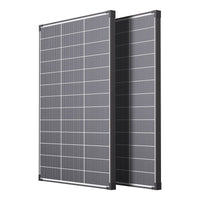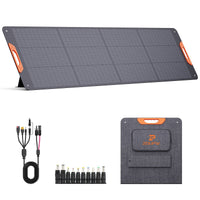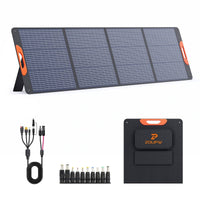Starlink and Solar: Powering Reliable Internet Off the Grid
In a world where connectivity has become a necessity, Starlink is rewriting the rules by delivering high-speed satellite internet to the most remote areas on Earth. But what happens when you’re miles from the nearest power outlet? That’s where pairing Starlink with solar technology, such as ZOUPW’s portable solar panels, creates a truly off-grid internet solution.

What Is Starlink?
Starlink is a satellite internet service developed by SpaceX, the private aerospace company founded by Elon Musk. Unlike traditional internet providers that rely on fiber-optic cables and cell towers, Starlink uses a constellation of thousands of low-Earth orbit (LEO) satellites to deliver broadband internet to homes, RVs, and businesses anywhere with a clear view of the sky.
How Does Starlink Work?
Each Starlink satellite orbits the Earth at an altitude of around 550 km. Signals are sent between the satellite and a user terminal (commonly referred to as the "dish") on the ground. This terminal connects to a Wi-Fi router that provides internet throughout your home, RV, or cabin. The low altitude of the satellites ensures lower latency and faster data speeds compared to traditional satellite internet.
Starlink Speeds: How Fast Is It Really?
According to recent user data, Starlink offers download speeds ranging from 50 Mbps to 250 Mbps, with upload speeds between 10 and 40 Mbps. Latency typically hovers between 20 and 40 milliseconds—good enough for video calls and even online gaming.
Starlink vs. 5G
While 5G offers fast speeds in urban areas, coverage is inconsistent in rural or mountainous regions. Starlink excels in these underserved areas by providing stable internet where 5G and fiber aren’t available.
| Comparison Items | Starlink | 5G |
|---|---|---|
| Network Coverage | Can easily bypass the limitations of traditional internet infrastructure and connect to devices in underserved and remote areas. | Offers better overall coverage than satellite options like Starlink, especially in densely populated and urban regions. But rural areas do not yet have comprehensive coverage. |
| Network Performance and Latency | Download speeds range from 50 - 250 Mbps. The LEO satellites have lower latency. | Download speeds range from 50 Mbps - 2 Gbps. Has better latency performance. |
| Network Capacity | The subscriber network is growing, and congestion issues may arise, degrading performance. | Has enormous network capacity (up to 1,000 times that of 4G) and has traffic - optimizing technologies like network slicing. |
| Security | Lacks a comprehensive security system to prevent potential breaches. Requires users to use a proxy server or secure VPN to avoid intrusion. | Has more integrated security protocols, such as end - to - end encryption. |
| Cost | The lowest monthly rate is $120, and there is a charge for equipment. | with options as low as $50 - 70 per month. Providers usually lease hardware to customers at a lower rate. |
Is Starlink Good for Gaming?
Yes—especially in rural locations with no other viable internet. While not as low-latency as fiber, Starlink performs well for most gaming experiences, especially strategy and role-playing games.
How Much Does Starlink Cost?
-
Residential Plan: $120/month + $599 for hardware
-
RV/Portable Plan: $150/month (pause anytime) + $599 for hardware
-
Business Plan: $250/month + $2,500 for premium hardware
These prices make it a competitive choice for rural residents and travelers who value high-speed access.
Installing Starlink: Don’t Forget Power
Starlink is easy to set up, but it does require reliable power—something that’s not always available in off-grid or mobile setups.
Common Mounting Options:
-
Roof mount for home installations
-
Starlink RV mount for mobile setups
-
Pole or ground mount for cabins or basecamps
While setup is straightforward, powering your Starlink system is critical — especially off-grid.
Power Requirements:
Starlink hardware consumes approximately 50–75W during operation. This means that reliable solar power can easily keep it running.
ZOUPW Solar Solution:
ZOUPW’s high-efficiency solar panels—like the 200W Foldable Solar Panel—can pair perfectly with Starlink when used with a power station. These panels come with USB, Type-C, and DC outputs, ideal for RVs, cabins, and emergency backup.

Does Starlink Work in Bad Weather?
Generally, yes. Starlink is designed to operate in rain, snow, and moderate storms. However, severe weather can impact performance temporarily.
| Environment Type | Performance | Influencing Factors and Countermeasures |
|---|---|---|
| Heavy Rain | Generally, the signal is not affected. In rare cases of severe heavy rain (accompanied by thick clouds and heavy rain), the signal may be attenuated, and in extremely rare cases, the connection may be interrupted. | Water vapor in the atmosphere can attenuate radio signals. Generally, no special measures are required. Just wait for the storm to end. |
| Snowfall | Starlink dishes are equipped with built-in heaters to melt snow.So during ordinary snowfall, it can work normally. In the case of extremely heavy snow, if the snow - melting speed cannot keep up with the accumulation speed, the signal will be interrupted. In rare cases, heavy snow and thick clouds will attenuate the signal, and it will return to normal after the storm. | In the case of extremely heavy snow, it may be necessary to manually clean the antenna. |
| Thunderstorm | The network can bypass the storm system to reduce the impact, and the antenna has lightning protection. However, in particularly severe thunderstorms (accompanied by thick clouds and heavy rain), the signal will be attenuated, resulting in a worse signal or a rare temporary disconnection, and it will return to normal after the storm. The more serious threat is power outage. | Water vapor and clouds in the atmosphere, as well as power outages. Use a surge protector to prevent power surges, and equip with a battery backup system to maintain the operation of equipment during power outages. |
| Hurricane | It can work, but hurricanes may damage the antenna. | Store the equipment indoors in advance for protection, and dry the cable if it gets wet. |
| Cloudy Weather | Speeds may drop, but service is usually maintained. | Clouds, rain, snow, and hail in the atmosphere. Use a surge protector and equip with a battery backup system to prevent power outages. |
| Power Outage | It cannot work | Lack of stable power supply. Having a solar panel and power station setup from ZOUPW ensures your internet and other essential electronics remain powered during power grid outages. |
FAQ: Starlink Essentials
Does Starlink work anywhere?
Almost—anywhere in the continental U.S., Alaska, and many other countries with an unobstructed view of the sky.
How do I use Starlink?
Order your kit, install the dish in a clear area, connect the power and router, and follow the Starlink app instructions.
What is a Starlink Mini?
Rumored as a more compact and portable version of the standard dish, ideal for mobile users.
How to reset Starlink router?
Press and hold the button on the router for 10 seconds until the lights blink.
How to cancel Starlink?
Log in to your Starlink account and manage your subscription. There are no contracts.
Who owns Starlink?
Starlink is operated by SpaceX.
Final Thoughts: A Future-Proof Pairing
For remote users, RV adventurers, and anyone living off-grid, Starlink paired with ZOUPW’s solar panels provides a future-proof solution to stay connected. Whether you’re in the mountains of Colorado or the deserts of Arizona, you can now have high-speed internet powered by the sun.
Explore our solar panel collection and build your off-grid internet setup today.
シェア





